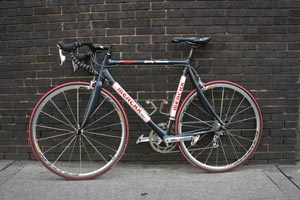 |
 |
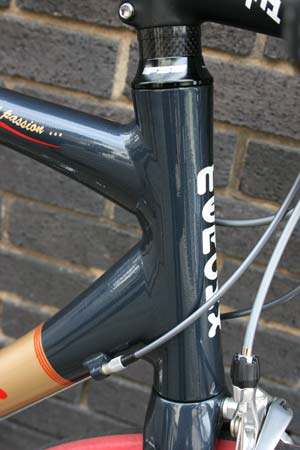 |
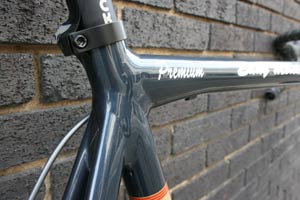 |
 |
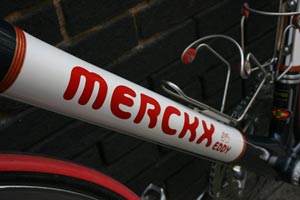 |
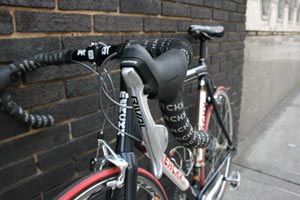 |
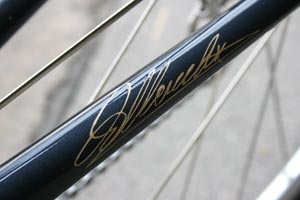 |
Eddy Merckx Premium Classic – £1,305 frame and fork any colour, plus £240 custom build option
Aluminium frames are a little out of fashion nowadays, as carbon fibre and its fellow composites make all the running at the sharp end of racing cycle manufacture. No real surprise there; once the engineers figured out how to really work with composites, their exceptional stiffness, especially in comparison to their weight, was always going to count in their favour. That’s not to say that aluminium frames no longer have anything to offer the discerning road cyclist, as the Premium Classic frame from Eddy Merckx makes abundantly clear.
First up, it is light at a whisker over 1kg for the 57cm size tested here. This is proper on-the-money poundage for a race bike, sub-800g carbon frames notwithstanding. Perhaps more impressive is the fact that the Premium is, quite simply, unimpeachably stiff. Many critics of aluminium will tell you that this is exactly what you’d expect; aluminium is notoriously stiff, so why should the Merckx be any different?
Well, aluminium, whether alloyed or not, is in fact much less stiff than either steel or titanium considered as a material. When employed in a structure, however, its low weight means a greater quantity of material – translating into more noticeably oversized tubes with thicker sidewalls – can be used while still saving precious grammes. Not only can, but must; otherwise, an aluminium frame will be much more flexible than the competition. Until oversizing came along, this was precisely the problem with frames such as the Alan and the Vitus Duralinox.
Even oversizing does not completely solve aluminium’s problems. There remains the ogre of fatigue, which eventually afflicts all aluminium components subject to cyclic flexure. One way to placate fatigue is to reduce the degree of flex in a loaded component; use more material, and it will shift around less and last longer. Do this to an aluminium frame and you have intentionally made it stiff in search of longevity, albeit while adding a fair bit of weight.
With the Premium, Merckx has found unquestionably the best solution yet to the problem. In fact, the tubes are made by Easton from 7000-series aluminium alloy with added scandium to improve post-weld durability, and the concept is Easton’s also. It was unveiled about three years ago, and is simple enough; the ends of the tubes are flared, creating a fluid shape that is easily mistaken for curvaceous carbon fibre from a distance. The advantage is equally simple; just as butting adds material where it is needed at the tube ends, flaring them adds geometric strength and stiffness. The frame tubes are loaded from their ends, and the maximum bending loads are applied there. The flared tube ends ensure that no part of the tube is subjected to excessive loadings, spread deflections along the length of the tube and maximise the size and strength of the welded join, which is traditionally the Achilles heel of aluminium.
The result is incredible stiffness and fatigue-resistance without the accompanying weight penalty, putting the Premium right at the top of the aluminium frameset league. Of course, there’s a lot more to it than fancy-Dan tubes, and it’s pretty well all good. Build quality is exceptional, from the brazed-on gear and brake cable bosses to the gracefully-curved seat stays and little logo button on the rear dropouts. If the example on test looks a little odd, that’s because it has bronze-painted panels on the right-hand side and white on the left, both on a frame colour that might charitably be described as dull. Don’t be put off; the purchase price includes any colour from the Merckx catalogue, and in any case the frame was painted this way because the legendary Belgian racer wanted to see which colour worked best as a panel.
Colour aside, the finish is exemplary, with a deep, rich coat of lustrous paint applied to super-smooth, virtually seamless welded joins. The meaty Easton all-carbon fork gets the same colour finish and looks great with it. The build, using SRAM’s Rival groupset, went largely without a hitch once an Italian bottom bracket assembly had been found. Apparently, Eddy has stuck with twin right-hand thread cups ever since Ugo de Rosa helped him set up his company in the late 70’s. Since our Truvative-sourced right-hand cup stayed firmly in place, this preference is of no real consequence apart from a slight question of ready availability.
Wheel choice was originally Mavic Ksyrium Elites, until a rear spoke broke towards the end of the Highclere Castle sportive. The Merckx then completed the Dragon Ride on hand-built Ultegra-10 hubbed hoops before receiving RCUK’s test pair of the new Mavic R-SYS wheelset in time for the editor to have a bash at a Crystal Palace crit. This is a pretty wide-ranging series of test scenarios, each of which the Premium passed with aplomb.
As a long-distance bike, it lacks nothing that tyres inflated to 90/95psi won’t supply. On initial viewing its beefy tubes and heft fork suggest implacable rigidity, and stiff they are. Let’s not pretend the curved seat stays flex appreciably; they don’t. However, the more than adequate wheelbase softens the ride and slows response to rider input; this, combined with seriously restrained steering geometry, offers the rider such a reassuring ride at any speed that no hint of anxiety or tension need intrude. Add in the bike’s lack of weight and the efficient power transfer associated with minimal frame flex and you have a tasty recipe for freshness at the end of a 200km sportive.
At the other end of the scale, the Merckx proved sure-footed and responsive on the tricky Crystal Palace circuit, its steady steering proving a blessing on both the bumpy, cut-up surface of the hairpin and the super-fast Lake left-hander. Make no mistake; this is one fine-handling machine.
So what’s wrong with it? Let’s just say that the proportions of the bike as set up here look a little odd to the modern eye; the top tube is perhaps a little high, the saddle low enough to make the bike look squat, even if the riding position is set up to the millimetre. In fact, this is the key to the problem. Put a slightly taller rider needing a higher saddle and longer stem on the same frame, and it would look much sharper. There is a sloping version of the Premium, built with the same flared tubeset, which offers a more current aesthetic, but the size range runs to five options compared to the 11 of the Classic, so finding the perfect fit may not be any easier. There is, however, a custom build option on both frames for an additional £240.
The tester, assuming he was in the market for a Premium Classic, might well have gone along this route and specified a lower top tube to the tune of perhaps 10mm, while retaining the head and top tube dimensions. That’s a lot of money to spend on a better look, when the standard frame fits perfectly, but if you are going to shell out over £1,300 in the first place, then why not pay a bit more to get it right? And if that sounds like a hefty bill for an aluminium frame, then bear in mind that this is about as good as they get, and a credible rival to any carbon frame at the price, which includes that excellent fork and an FSA headset. If you are looking for a more classical frame that lacks nothing in performance, finish or build quality, look no further.
Sizes 48, 50, 52, 53, 54, 55, 56, 57, 58, 60, 62cm
Verdict
Superb handling scandium-aluminium frameset with cutting edge engineering allied to classical appearance
 Lightweight, stiff, fine handling
Lightweight, stiff, fine handling
 Expensive custom build option
Expensive custom build option






